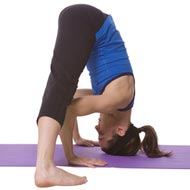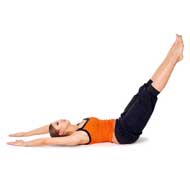- Mountain Pose
- Five pointed star pose
- Goddess Pose
- Cresent Moon Pose
- Chair pose
- Warrior I Pose
- Warrior II Pose
- Side Angle Pose
- Triangle Pose
- High Lunge
- Revolved Side Angle Pose - Parivrtta Parsvakonasana
- Lord of the Dance Pose
- Garland Pose
- Standing Split
- Revolved Triangle Pose
- Extended Triangle Pose
- Low Lunge
- Upward Forward Fold
- Big Toe Pose
- Extended Side Angle Pose
- Dolphin Pose
- Standing Forward Bend
Wide-Legged Forward Bend - Prasarita Padottanasana
The Wide Legged Forward Bend is a simple yoga pose ideal for beginners and those who want to lose belly fat. Also known as Prasarita Padottanasana, this pose has several therapeutic applications and can also be used to stretch before performing any other kind of exercises.
This pose offers a complete stretch to all parts of your body.
Steps :
- Start in the Tadasana pose. Take a deep breath and hop lightly to spread your feet apart. Allow your feet to be 3 to 4 feet apart.
- Rest both your hands on your waist, right above your buttocks, placing your feet parallel to each other. Draw up on the inner parts of your ankles to left the inner arches of your legs. Place your feet firmly on the floor and draw the thigh muscles so that you can engage them too.
- Take in a deep breath, and lift your chest. Allow your front torso to be longer than your back.
- Exhale and keep lengthening the front of your torso. Lean towards your front slowly, allowing your chest and shoulders to get parallel to the ground.
- Reach out your hands and press your fingertips right in front of you. Keep your back and your torso in a slightly concave position. Raise your head so that your gaze is upwards and you are looking toward the ceiling.
- Push the top of your thighs backwards to lengthen your torso even further. Take in several deep breaths and keep exhaling as well.
- Bend your elbows and lean in further, bending your torso from the hips.
- Try and rest the crown of your head on the floor in front of you.
However, if you are not able to put your head on the ground, you can simply let it be. Be sure to keep lengthening your torso and keep it as stretched as possible. - Press the inner parts of your palms into the floor. Keep your fingers pointing forward. Advanced yoga practitioners can bend their torso completely, but for beginners, it may take some time for you to bend like that.
- Draw your shoulders backwards, away from your ears and stay in the pose for at least 30 seconds. If you are comfortable, you can prolong the stretch and stay in the pose for at least one minute.
- Take in a deep breath and come back into the Mountain Pose.
Precautions :
- For those suffering from lower back problems, pains, and injuries, it is best to avoid full forward bends.
- Apart from this, there are no specific Wide Legged Forward Bend precautions
Beginner's Tip :
The best beginner's tip for Wide-Legged Forward Bend is to place a soft padded yoga block or a soft folded blanket in front and place the crown of your head on the block of the blanket. Since beginners are usually not able to bend completely and place their crown on the floor, this helps maintain balance while still improving your stretch.
Benefit To Body Part :
- It helps improve blood circulation to the brain, thus revitalizes the body and calming the mind.
- It is a good stretch for the entire body, and it help tone the muscles in the calves, groin, and hip region.
- It particularly helps stretch and strengthen the hamstrings and the spine.
- It provides a good massage for internal organs such as the kidneys and liver.
Therapeutic Applications :
It can be used to combat the following:
- Fatigue
- Headache
- Mild depression
Variations :
- Instead of pressing your palms to the floor, you can move them behind your back and hold them together while you are bending.
- If you can, you may also join your hands in the Anjali Mudra while performing the bend.
Preparatory Poses :
- Reclining Bound Angle Pose (Supta Baddha Konasana)
- Downward Facing Dog Pose (Adho Mukha Svanasana)
- Standing Forward Bend (Uttanasana)
Follow Up Poses :
- Bound Angle Pose (Baddha Konasana)
- Seated Forward Bend (Paschimottanasana)
- Crane Pose (Bakasana)
- Extended Side Angle Pose (Utthita Parsvakonasana)
- Head Stand (Sirsasana)



